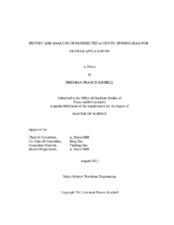| dc.description.abstract | The inherent nature of distributed acoustic sensing technology is a direct result of two key components: optical fiber and the speed of light. Because the speed of light is constant and optical fiber is an isolated medium, combining the two creates a mechanism insulated from environmental interference that effectively “moves” at the speed of light. This process is most visible in the telecommunications industry where the technology transports large amounts of data over significant distances at very high speeds.
The same factors that make optical fiber excellent for transporting data (high speed and low environmental interference) also make the technology very applicable for precise measuring applications. Because optical fiber is insulated, a change to the fiber will have a pronounced (measurable) effect. These measurable effects manifest themselves as changes in the amount of light that is reflected within the optical fiber. This change in reflected light can be measured and quantified to indicate both the specific location along the fiber where the change in reflection occurred and the magnitude of the change in reflection. Knowing both the location of the affected area and the extent to which the reflection changed allows for precise measuring and subsequently, educated inferences about what caused the changes initially. The ability of optical fiber to detect changes at myriad intervals over long distances has particular appeal for functions involving remote and hard to get to environments. Both of these conditions are inherent to the petroleum industry and provide substantial incentive for investigating DAS for oilfield applications. | en |


